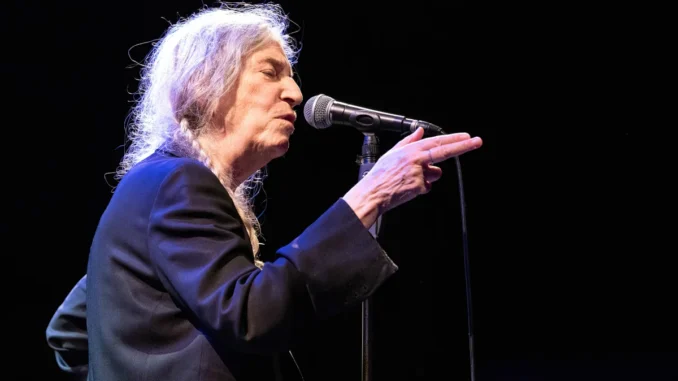
Patti Smith at St. Paul’s Cathedral: A Transcendent Rock and Roll Communion
On a chilly September evening in 2024, an extraordinary musical event took place within the hallowed walls of St. Paul’s Cathedral in London. Patti Smith, the legendary poet, rock icon, and cultural provocateur, delivered a performance that transcended the boundaries of rock and roll and traditional sacred space. The evening felt like a spiritual communion between music, art, and history—a rare, profound connection that left those in attendance awestruck.
The grandeur of St. Paul’s Cathedral, with its baroque architecture and soaring dome, was the perfect backdrop for Smith’s raw, poetic energy. The venue, typically reserved for religious ceremonies, memorials, and classical performances, became the stage for one of rock’s most enduring voices. It wasn’t just a concert; it was an event that reverberated with a sense of occasion and transcendence.
### A Singular Setting
The choice of St. Paul’s Cathedral for this concert was significant. St. Paul’s, designed by Sir Christopher Wren in the late 17th century, is one of London’s most iconic landmarks and a symbol of resilience, having survived the Blitz during World War II. For Patti Smith, who has long been associated with themes of rebellion, faith, and artistic exploration, it was the ideal venue for a performance that would explore the sacred and profane in equal measure.
As the audience filled the cathedral, there was a palpable sense of anticipation. The crowd, an eclectic mix of long-time fans, art enthusiasts, and curious first-timers, seemed to recognize that they were about to witness something unique. Smith’s reputation for blending poetry and music into a deeply emotional experience set the tone for the evening.
The Performance
Patti Smith’s setlist for the evening drew heavily from her storied career, blending her classic rock anthems with moments of quiet reflection. Opening with “Dancing Barefoot,” Smith immediately established a sense of intimacy, her voice echoing off the cathedral’s high ceilings, creating a haunting and ethereal soundscape. The song’s lyrics, full of yearning and spirituality, seemed to take on new meaning within the sacred space.
Throughout the performance, Smith’s ability to bridge the gap between rock and poetry was on full display. Songs like “Ghost Dance” and “My Blakean Year” delved into themes of loss, faith, and redemption, resonating with the religious history of the venue. Accompanied by longtime guitarist Lenny Kaye, Smith’s stripped-down arrangements allowed her lyrics to shine, each word imbued with weight and significance.
The highlight of the evening came when Smith performed her iconic song “Gloria.” As the opening lines, “Jesus died for somebody’s sins, but not mine,” echoed through the cathedral, the audience was drawn into the tension between the sacred and the rebellious. Smith’s voice, both defiant and reverent, seemed to capture the essence of the evening—an exploration of faith and doubt, of reverence and rebellion.
A Spiritual Exchange
What made the performance particularly moving was Smith’s interaction with the audience and the space itself. Between songs, she paused to reflect on the significance of performing in such a historic and sacred setting. She spoke about the cathedral’s resilience during wartime and the importance of art in times of crisis, reminding the audience that music and poetry can be sources of healing and hope.
The audience responded in kind, hanging on every word, often breaking into spontaneous applause or moments of quiet reflection. There was a sense that everyone in the room was part of something larger than just a concert—that they were participants in a shared spiritual experience.
Smith also took time to honor the artists and poets who had influenced her throughout her career. She recited poetry by William Blake and Allen Ginsberg, paying tribute to their visionary works, which, like her own, often grappled with themes of faith, revolution, and transcendence. These moments of spoken word felt like prayers, spoken in the sacred halls of the cathedral, adding another layer of depth to the evening.
A Lasting Impact
By the time the final chords of “Because the Night” rang out, there was a palpable sense that the evening had been more than just a performance. It had been a communion—between artist and audience, between past and present, between the profane and the sacred. Smith’s raw, unfiltered emotion, coupled with the grandeur of St. Paul’s Cathedral, created an experience that was both deeply personal and universally resonant.
As the audience slowly filed out of the cathedral, there was a sense that they had been part of something rare and magical. Patti Smith had not only performed music; she had created a moment of collective introspection, a celebration of the power of art to transcend the everyday and touch something eternal. For those lucky enough to be in attendance, it was a night that would not soon be forgotten—a transcendent rock and roll communion in one of the world’s most sacred spaces.
Be the first to comment